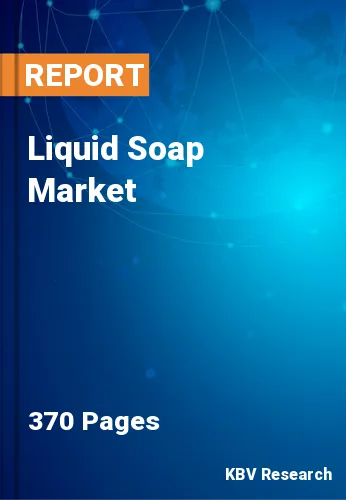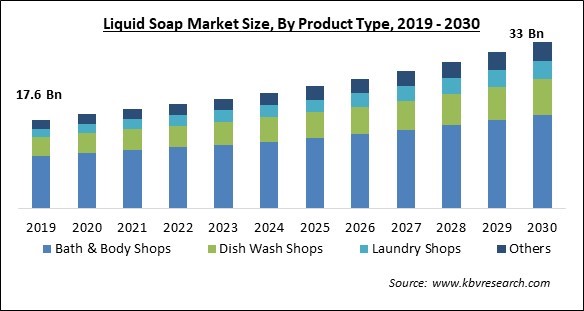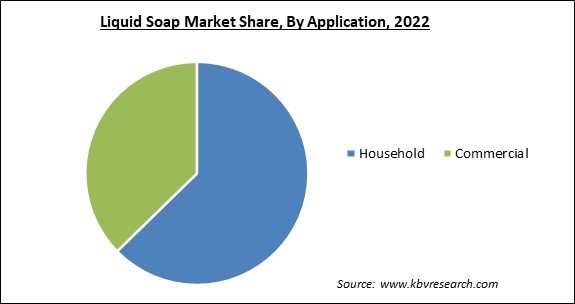
The Global Liquid Soap Market size is expected to reach $33 billion by 2030, rising at a market growth of 6.2% CAGR during the forecast period.In the year 2022, the market attained a volume of 2,603.6 million litres, experiencing a growth of 7.2% (2019-2022).
Contactless fittings are finding their way into domestic bathrooms and kitchens as a result of the pandemic. Hence, Household segment acquired $12,967.1 million revenue in the market in 2022. Members of the family are accustomed to cleaning their hands as soon as they enter the house. Because families wish to prevent bacteria and viruses from invading their home, the home bathroom or kitchen sink have abruptly become even more of a focal point. Hand washing eliminates germs on the hands, but if individuals use touch faucets and soap or sanitizer dispensers, the subsequent family member who touches that contaminated surface can unintentionally contract an infection. Some of the factors impacting the market are rising consciousness about health and hygiene, growing interest in natural and organic goods, and presence of toxic substances.

The market is anticipated to grow because of the increased awareness of sanitation and cleanliness among the world's population. Government agencies from many nations are taking the lead in encouraging people to maintain personal hygiene standards, such as maintaining hygienic conditions in public restrooms. In addition, rising hygiene consciousness in developing nations like Mexico, South Africa, Brazil, and India, among others, is anticipated to increase product demand. Hence, all increasing consciousness of hygiene among users will aid in the expansion of the market throughout the forecast period. The increasing global trend toward adopting organic products is aiding in product development. Due to their antibacterial characteristics, herbal ingredients like basil and neem (Azadirachta indica)-based products are becoming more and more popular in the market. As an illustration, certain liquid soap products now come with essential oils like rosemary, peppermint, or lavender. These distinctive scents offer not only a pleasurable experience but also extra advantages including relaxation, stress alleviation, and skin nourishment. Hence, such initiatives by players are probably going to help the market grow during the anticipated period.
However, businesses are being hampered by the use of hazardous compounds in soapy goods like parabens & triclosan, which are known to be bad for the skin. Additionally, a lot of packaging material, like plastic, is needed to ensure that the liquid form of soap does not leak. Corporations incur additional packing expenditures as a result, which raises the ultimate product cost. Additionally, compared to bar soap, the creation of liquid soap takes five times as many raw materials and components, as well as 20 times as much energy for packaging. Therefore, it is projected that all of the issues above will slow the growth of the market.
By product type, the market is segmented into bath & body soaps, dish wash soaps, laundry soaps, and others. In 2022, bath and body soaps segment garnered the highest revenue share in the market. The adoption of sound hygiene habits, such as proper hand washing and general cleanliness at home and in hospitals, schools, and restaurants, is fostering the expansion of this segment. Furthermore, compared to solid bars, younger people are more likely to utilize liquid hand soaps & shower products. Due to the fact that bar soaps are frequently contaminated with germs, businesses advertise their products as "antiseptic liquid soaps" and "germ protecting liquid soaps" to encourage use, which is luring consumers and fostering market expansion.
Based on application, the market is bifurcated into household and commercial. The commercial segment recorded a significant revenue share in the market in 2022. The growing health consciousness amongst working professionals and the rising frequency of communicable infectious diseases are the major reasons why demand for organic liquid soap in the commercial segment is expanding. Additionally, there are a number of government initiatives and company standards for employee health and safety, which will likely fuel the use of liquid soaps.

On the basis of distribution channel, the market is divided into supermarkets/hypermarkets, convenience stores, online sales channel, and others. The supermarkets/hypermarkets segment procured the highest revenue share in the market in 2022. A wide variety of liquid soap options are readily available in supermarkets and hypermarkets. The development of emerging economies is driving the expansion of supermarkets and hypermarkets. The demand for retail venues, like supermarkets and hypermarkets, develops as these economies develop, which in turn fuels the demand for liquid soap products.
| Report Attribute | Details |
|---|---|
| Market size value in 2022 | USD 20.7 Billion |
| Market size forecast in 2030 | USD 33 Billion |
| Base Year | 2022 |
| Historical Period | 2019 to 2021 |
| Forecast Period | 2023 to 2030 |
| Revenue Growth Rate | CAGR of 6.2% from 2023 to 2030 |
| Number of Pages | 370 |
| Number of Table | 710 |
| Quantitative Data | Volume in Million Litres, Revenue in USD Million, and CAGR from 2019 to 2030 |
| Report coverage | Market Trends, Revenue Estimation and Forecast, Segmentation Analysis, Regional and Country Breakdown, Companies Strategic Developments, Company Profiling |
| Segments covered | Product Type, Application, Distribution Channel, Region |
| Country scope | US, Canada, Mexico, Germany, UK, France, Russia, Spain, Italy, China, Japan, India, South Korea, Singapore, Malaysia, Brazil, Argentina, UAE, Saudi Arabia, South Africa, Nigeria |
| Growth Drivers |
|
| Restraints |
|
Region-wise, the market is analyzed across North America, Europe, Asia Pacific, LAMEA. In 2022, the North America region garnered the maximum revenue share in the market. The regional public is familiar with liquid soap and can easily get it in stores because it was originally introduced in the U.S. Additionally, due to disease outbreaks like SARS in 2003 and H1N1 influenza in 2009, people are increasingly mindful of sanitation. Numerous families with high earnings constantly seek the highest-quality goods, regardless of cost. The primary consumers of liquid soaps in these nations are the hotel and restaurant industries.
The market research report covers the analysis of key stake holders of the market. Key companies profiled in the report include The Procter and Gamble Company, Kimberly-Clark Corporation, 3M Company (3M Health Information Systems), Henkel AG & Company, KGaA, Reckitt Benckiser Group PLC, Kao Corporation, Unilever PLC, The Colgate Palmolive Company, Lion Corporation, and Johnson & Johnson
Free Valuable Insights: Global Liquid Soap Market size to reach USD 33 Billion by 2030
By Product Type(Volume, Million Litres, USD Million, 2019-2030)
By Application(Volume, Million Litres, USD Million, 2019-2030)
By Distribution Channel(Volume, Million Litres, USD Million, 2019-2030)
By Geography(Volume, Million Litres, USD Million, 2019-2030)
This Market size is expected to reach $33 billion by 2030.
Rising Consciousness About Health and Hygiene are driving the Market in coming years, however, Presence of Toxic Substances restraints the growth of the Market.
The Procter and Gamble Company, Kimberly-Clark Corporation, 3M Company (3M Health Information Systems), Henkel AG & Company, KGaA, Reckitt Benckiser Group PLC, Kao Corporation, Unilever PLC, The Colgate Palmolive Company, Lion Corporation, and Johnson & Johnson
In the year 2022, the market attained a volume of 2,603.6 million litres, experiencing a growth of 7.2% (2019-2022).
The Household segment is leading the Market by Application in 2022; thereby, achieving a market value of $19.4 billion by 2030.
The Asia Pacific region dominated the Market by Region in 2022, and would continue to be a dominant market till 2030; thereby, achieving a market value of $12.7 billion by 2030.
Our team of dedicated experts can provide you with attractive expansion opportunities for your business.
